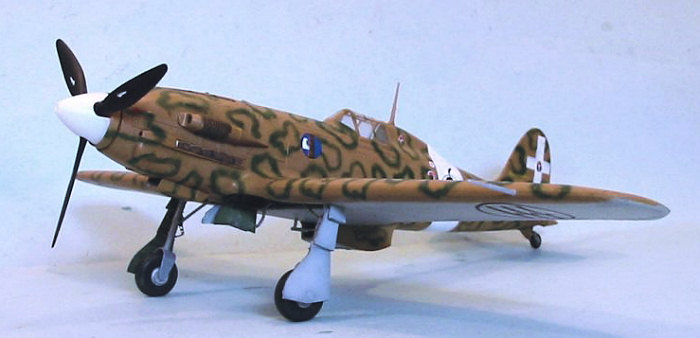
| KIT #: | ? |
| PRICE: | $9.98 |
| DECALS: | Three options |
| REVIEWER: | Tom Cleaver |
| NOTES: |

| HISTORY |
The failure of the Italian aircraft industry to develop a high-powered domestic aircraft engine led to the situation where all the fighter aircraft of the Regia Aeronautica after the Fiat C.R.32 were outperformed by their opponents. It is nearly impossible to look at the Macchi C.200 and realize that it had a pedigree in Schneider Cup air racing history that was as important as that of the Supermarine Spitfire, with its sire being the incredible Macchi C.72 racer, the fastest seaplane racer to ever fly. Unfortunately, the C.200 was saddled with the low-powered Fiat A.74 radial and a requirement that the pilot be provided maximum visibility, resulting in the aircraft’s humpbacked appearance, so that all this aeronautical DNA appeared wasted. However, the next development of the basic design regained all the grace and look of speed associated with the M.52 and M.C. 72 racers Mario Castoldi had created.
All it took to accomplish this was the replacement of the Italian engine with a German Daimler-Benz DB601A, one of the finest piston aero engines ever designed and built, which Alfa-Romeo had acquired a license to produce in November 1939. Unfortunately, Alfa-Romeo never seemed to get things right with their version of the engine - the R.A.1000 R.C.41 Monsone (Monsoon) - which presented nothing but problems and a complete lack of mechanical reliability when produced, with a production rate that never exceeded 50 a month. This forced Macchi to rely on an ever-dwindling and never reliable supply of German engines for their fighter.
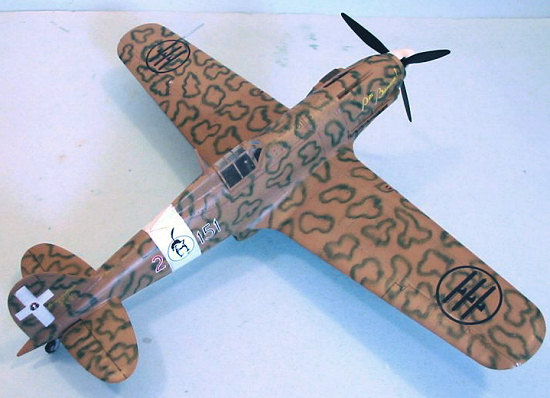 First flown on August
10,1940, with its German engine providing in excess of 1,000 horsepower that
increased top speed from the C.200's 315 mph to 370 mph, and with a graceful,
streamlined fuselage, the Macchi C.202 was the immediate equal of such aircraft
as the Supermarine Spitfire and later the North American P-51 in terms of
overall performance. It could more than hold its own with the P-38 Lightning,
and was superior to the Hawker Hurricane, P-40 Warhawk, and P-39 Airacobra. The
Folgore could turn inside all its opponents including the Spitfire, which was
the only Allied fighter that could outclimb the Castoldi fighter. With
finger-light aerodynamic controls and outstanding maneuverability, its only
fault was that its armament was too light: originally set at two 50-caliber
machine guns with 400 rpg each mounted in the fuselage and firing through the
prop, this was supplemented in later production batches by the provision of a
single 30-caliber machine gun with 500 rpg in each outer wing.
First flown on August
10,1940, with its German engine providing in excess of 1,000 horsepower that
increased top speed from the C.200's 315 mph to 370 mph, and with a graceful,
streamlined fuselage, the Macchi C.202 was the immediate equal of such aircraft
as the Supermarine Spitfire and later the North American P-51 in terms of
overall performance. It could more than hold its own with the P-38 Lightning,
and was superior to the Hawker Hurricane, P-40 Warhawk, and P-39 Airacobra. The
Folgore could turn inside all its opponents including the Spitfire, which was
the only Allied fighter that could outclimb the Castoldi fighter. With
finger-light aerodynamic controls and outstanding maneuverability, its only
fault was that its armament was too light: originally set at two 50-caliber
machine guns with 400 rpg each mounted in the fuselage and firing through the
prop, this was supplemented in later production batches by the provision of a
single 30-caliber machine gun with 500 rpg in each outer wing.
While the C.202 Folgore (Lightning) could equal its opponents on an individual plane-vs-plane level, the Italian aviation industry was incapable of anything approaching real mass production. Thus, between its appearance in the Spring of 1941 and the end of the Italian fascist state in September 1943, only
1,200 C.202s, in 11 series were produced in total. Of these, Macchi produced 392, with the rest being built under license by Breda and SAI Ambrosini. Even with this, by the Spring of 1942 the Folgore outnumbered all other fighters in the inventory of the Regia Aeronautica.
Delivery of the first production aircraft, C.202 Series I, to 1º Stormo C.T.,
a specially formed conversion unit in Udine, commenced during the summer of
1941. The C.202s made their combat debut on the Libyan front on November 25,
1941. Two further Folgore-equipped Gruppi arrived in Libya
following the failure of the second British Western Desert offensive that
December. The Folgore’s next appearance was over Malta with the 51º Stormo
C.T. in early 1942, flying from bases in Sicily. Beyond service in North
Africa and Sicily, the C.202 was in limited service on the Eastern Front with
the 21º Grupo after November 1942, where a total of 18 C.202s
operated with a force of 48 C.200s. Together with the three Squadriglia of
C.200s, the Folgores achieved an 88 to 15 victory/loss ratio by the time
the unit was withdrawn from the Eastern Front in February 1943 following the
defeat at Stalingrad.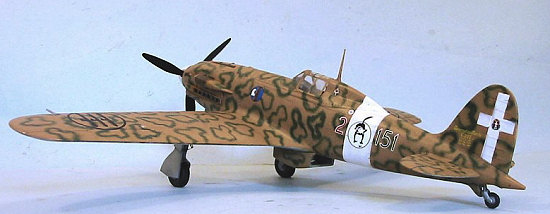
Following the Armistice in September 1943, C.202s were used by both the Italian Co-Belligerent Air Force operating with the Allies, and with the Aviazione Dells R.S.I. which continued to operate with the Germans. The C.202 was used as a trainer in the north, while it was operated in limited service in the South while engines were available, flying with the Balkans Air Force.
After the war, 41 C.202 airframes were fitted with license-built Daimler-Benz DB 605 engines and sold to Egypt as C.205 Veltros.
The C.202 illustrated both the promise and the problems of the Italian aviation industry. As a design, it was excellent, and the equal of its opponents. Unfortunately the industrial base of Italy could not provide the airplane in the numbers needed.
| THE KIT |
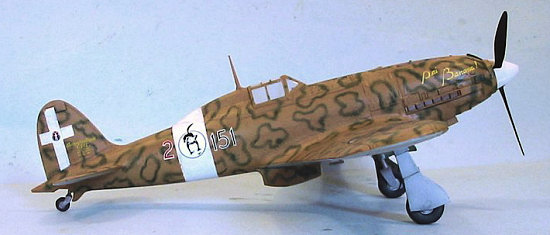 The 21st
Century Toys Macchi C.202 is a limited production version of their pre-build
collectible series of models. As such, it has a very simple design with few
parts, and is meant to be screwed together. The kit also provides a first-rate
decal sheet, which alone is worth the retail price of $9.95.
The 21st
Century Toys Macchi C.202 is a limited production version of their pre-build
collectible series of models. As such, it has a very simple design with few
parts, and is meant to be screwed together. The kit also provides a first-rate
decal sheet, which alone is worth the retail price of $9.95.
The kit has enough similarity in some parts to the Pacific Coast Models C.202 kit that parts from the 21st Century Toys kit could be modified for use to replace the badly-designed parts on the PCM kit, like the lower nose panel. Additionally, the 21st Century Toys kit has a correct sized and shaped prop spinner that would be useful to replace the incorrect one in the more expensive kit.
| CONSTRUCTION |
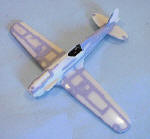 I set out to see if the 21st Century Toys kit could be upgraded into
a model that could stand comparison with other “serious” scale models. My PCM
C.202 model had met an unfortunate end last summer when I came to the
realization that no amount of work to correct its faults was ever going to make
it right. Before dumping it in File No. 13, I removed the spinner, the landing
gear, and the cockpit, setting them aside for some future use. When I received
the 21st Century Toys kit, I immediately thought of using these saved
parts to upgrade this kit. As it turned out, this was a bit more than is really
needed with this kit. The two really useful parts were the prop, which has the
correct-shaped blades, those in the 21st CT kit being the paddle
blades more appropriate to the C.205 Veltro, and the landing gear. The
gear doors and wheels of the 21st Century Toys kit are too small, so
using the right-size parts from the other kit vastly improved the overall look
of the kit.
I set out to see if the 21st Century Toys kit could be upgraded into
a model that could stand comparison with other “serious” scale models. My PCM
C.202 model had met an unfortunate end last summer when I came to the
realization that no amount of work to correct its faults was ever going to make
it right. Before dumping it in File No. 13, I removed the spinner, the landing
gear, and the cockpit, setting them aside for some future use. When I received
the 21st Century Toys kit, I immediately thought of using these saved
parts to upgrade this kit. As it turned out, this was a bit more than is really
needed with this kit. The two really useful parts were the prop, which has the
correct-shaped blades, those in the 21st CT kit being the paddle
blades more appropriate to the C.205 Veltro, and the landing gear. The
gear doors and wheels of the 21st Century Toys kit are too small, so
using the right-size parts from the other kit vastly improved the overall look
of the kit.
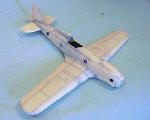 The cockpit from the PCM kit didn’t really fit and required a lot of surgery.
In retrospect, inasmuch as I closed the canopy to preserve the good lines of the
aircraft, the cockpit supplied in the kit would have been more than enough and
would have looked good without requiring the hassle I created for myself with
this choice. I did vacuform the canopy, using the too small 21st
Century Toys canopy as the mold; this resulted in a canopy that was the correct
size.
The cockpit from the PCM kit didn’t really fit and required a lot of surgery.
In retrospect, inasmuch as I closed the canopy to preserve the good lines of the
aircraft, the cockpit supplied in the kit would have been more than enough and
would have looked good without requiring the hassle I created for myself with
this choice. I did vacuform the canopy, using the too small 21st
Century Toys canopy as the mold; this resulted in a canopy that was the correct
size.
The kit surface detail is a bit heavy. I sanded down the overdone ribs in the fabric covered control surfaces, which was really all that needed to be done. I then outsmarted myself by filling in the panel lines with Mr. Surfacer 500, sanding them smooth when dry, and rescribing them. The result does not look as good as hoped. In fact, the heavy panel lines of the kit would have looked just fine under several coats of paint.
| COLORS & MARKINGS |
Painting:
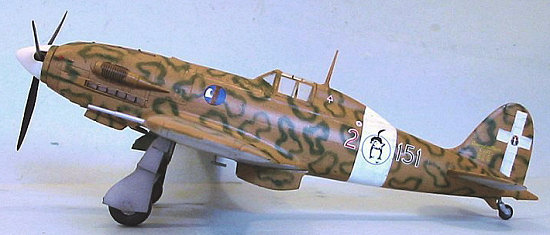 I used Xtracrylix Medium
Grey for the lower color, and a mixture of Xtracrylix RLM 79 Tan and British
Middle Stone for the upper color, with the “smoke rings” done with Xtracrylix
U.S. Medium Green. While many modelers want a neat appearance with these smoke
rings and opt for the Mike Grant decals, the truth is the smoke rings should be
ragged. They were applied by spraygun, with no two airplanes receiving the same
pattern since the rings were done freehand. Depending on the individual
painter, the rings appear in photographs to go from “ragged” to “very ragged” in
appearance. Any modeler with an airbrush can apply this camouflage pattern and
“get it right” since there is no “right” to achieve. When this was done, the
model was given a coat of Xtracrylix Gloss Varnish.
I used Xtracrylix Medium
Grey for the lower color, and a mixture of Xtracrylix RLM 79 Tan and British
Middle Stone for the upper color, with the “smoke rings” done with Xtracrylix
U.S. Medium Green. While many modelers want a neat appearance with these smoke
rings and opt for the Mike Grant decals, the truth is the smoke rings should be
ragged. They were applied by spraygun, with no two airplanes receiving the same
pattern since the rings were done freehand. Depending on the individual
painter, the rings appear in photographs to go from “ragged” to “very ragged” in
appearance. Any modeler with an airbrush can apply this camouflage pattern and
“get it right” since there is no “right” to achieve. When this was done, the
model was given a coat of Xtracrylix Gloss Varnish.
Decals:
The kit decals went on without problem under a coat of Micro-Sol. When dry, the model was washed and a coat of Xtracrylix Satin Varnish was applied.
| FINAL CONSTRUCTION |
I gave the model two coats of Xtracrylix Flat Varnish. When this was dry, the canopy was unmasked and the landing gear attached.
| CONCLUSIONS |
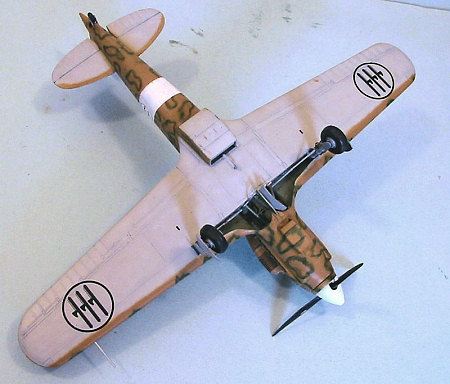 This kit has a better
overall shape than the Pacific Coast Models Macchi C.202 kit, though that kit
has more detail. As noted above, at a price of $9.95 for the 21st
Century Toys kit, it could be used as an “aftermarket correction set” for the
PCM kit. That said, the kit makes up into a nice model on its own, with easy
assembly and the only item that really needs replacement being a set of main
wheels the right size. With the fabric control surfaces sanded down, this kit
becomes a very nice model of one of the most beautiful fighters used by any of
the combatants of the Second World War.
This kit has a better
overall shape than the Pacific Coast Models Macchi C.202 kit, though that kit
has more detail. As noted above, at a price of $9.95 for the 21st
Century Toys kit, it could be used as an “aftermarket correction set” for the
PCM kit. That said, the kit makes up into a nice model on its own, with easy
assembly and the only item that really needs replacement being a set of main
wheels the right size. With the fabric control surfaces sanded down, this kit
becomes a very nice model of one of the most beautiful fighters used by any of
the combatants of the Second World War.
April 2007
Copyright ModelingMadness.com. All rights reserved. No reproduction in part or in whole without express permission.
If you would like your product reviewed fairly and fairly quickly, please contact the editor or see other details in the Note to Contributors.